Future of SAARC
If South Asia achieves economic integration, it could emerge as the second largest economy in the world.

Five interrelated policy challenges need to be addressed at the individual country level on the basis of regional cooperation within the SAARC framework: (i) Rapid implementation of free trade and investment envisaged in the South Asian Free Trade Agreement needs to be undertaken. Inspite of commendable recent progress, South Asia remains the least integrated region in the world. Intra-regional trade as a share of total trade in South Asia remains at about five per cent, which is the lowest for any region in the world. Other measures of integration such as cross-border investment; cross-border movement of people; sharing of ideas; communication as measured by telephone calls (only seven per cent of international telephone calls are regional, compared to 71 per cent in East Asia); and transfer of technology and royalty payments are all extremely low. Achieving greater economic integration will require substantially improved regional connectivity and overcoming interstate tensions and mistrust; (ii) The process of economic integration and the welfare of people should not be held hostage to the resolution of interstate disputes. Indeed, as economic integration is undertaken, new constituencies for peace will emerge that will facilitate the resolution of interstate disputes. Nevertheless, the core issues of cross-border terrorism and outstanding territorial disputes such as Kashmir must be addressed to establish the basis of lasting peace; (iii) Inspite of impressive economic growth rates in the last two decades, mass poverty persists in South Asia as this region is home to half of the world’s poor population. Therefore, it is necessary to change the structure of the existing elite-based economic growth process which induces increasing income inequalities and constricts the poverty reduction effect of growth. A new inclusive growth process needs to be undertaken whereby the middle classes and the poor can have access to productive resources, high wage employment and equitable access over factor and product markets. Saarc can provide the framework for sharing and pursuing best practices in this regard; (iv) Strengthening democracy by making it more participatory. This involves creating institutional structures for decentralised governance from the federal to the provincial/state, district and down to the grassroots levels: the purpose being to enable people to participate systematically in decisions that affect their economic and social life, their physical security and the life-support systems of the natural environment; (v) Climate change and the expected intensification of existing water stress in some countries of South Asia, food shortages and rising sea levels threaten the stability of economies and societies in South Asia. Regional cooperation to undertake joint adaptation and mitigation measures to face this crisis are therefore necessary.
The future of South Asia is delicately poised like a dewdrop on a blade of grass. We need to draw upon our civilisational wellsprings of innovativeness to chart a new course for ourselves and the world.
Published in The Express Tribune, November 15th, 2011.












COMMENTS
Comments are moderated and generally will be posted if they are on-topic and not abusive.
For more information, please see our Comments FAQ